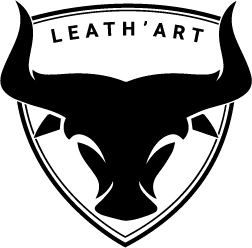The journey to crafting premium leather goods begins with the careful selection of the finest hides. This is a crucial step in ensuring the quality, durability, and overall excellence of the final product. Premium leather is characterized by its superior texture, appearance, and longevity.
Leath’Art source hides from various animal species, including cows, goats, sheep. The premium leather selection involves a careful balance of factors like leather type, tanning process, texture, thickness, color, and ethical considerations. Moreover the quality of the leather is also affected by several factors as the animal’s age, diet, and living conditions.

- Durability: Premium leather should be able to withstand wear and tear, making it a long-lasting material for various applications. Durability ensures that the leather goods remain in excellent condition for many years.
- Texture: A pleasing and consistent texture is crucial. High-quality leather should have a smooth, uniform surface without blemishes or irregularities. The texture can vary depending on the type of leather, but it should be visually appealing and tactilely satisfying.
- Flexibility: Leather should be supple and flexible, allowing it to conform to shapes and movements. This characteristic is essential for products like bags, wallets, and shoes, as it contributes to comfort and usability.
- Strength: While being flexible, leather should also be strong and resilient. It should resist stretching and tearing, ensuring that it can handle daily use and abuse.
- Grain: The grain pattern on the leather’s surface is an important aesthetic element. Full-grain leather retains the natural grain, giving it a unique and authentic appearance. The grain should be even and free from excessive blemishes.
- Color Fastness: The leather should retain its color over time, resisting fading and discoloration due to exposure to sunlight or other environmental factors. High-quality dyes and finishes are essential for color retention.
- Natural Markings: Some natural markings, like scars, wrinkles, and insect bites, can add character to leather. These markings should be minimal and not compromise the leather’s structural integrity.
- Aging Patina: Premium leather often develops a beautiful patina as it ages. This is a desirable quality for many leather enthusiasts, as it adds character and depth to the leather’s appearance.
- Tanning Process: The tanning process is crucial in determining the leather’s quality. Vegetable tanning, for example, is known for its eco-friendliness and ability to develop a rich patina over time. Chrome tanning results in a softer and more supple leather.
- Smell: High-quality leather has a distinctive, pleasant smell. It should not have a chemical or unpleasant odor, which can be a sign of poor tanning or low-quality materials.
- Consistency: Leather should have consistent quality throughout the hide or batch. Variations in texture, color, or thickness should be minimal, ensuring that all pieces used in a project have the same high standards.
- Sustainability: In today’s environmentally conscious world, sustainable leather sourcing and tanning methods are increasingly important. The best leather should align with responsible and ethical practices, including responsible animal husbandry and eco-friendly tanning processes.
When choosing leather for a particular project or product, we consider these characteristics in conjunction with specific needs and preferences. Ultimately, the “best” leather characteristics depends on the intended use and the aesthetic that aligns with our product’s needs and the values of our brand, which it’s a commitment to sustainability, traditional craftsmanship & timeless elegance.
Leath’Art | Sep 2023

